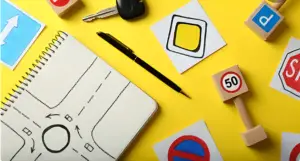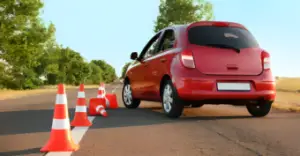Defensive Driving: How to Live Secure on the Street
Defensive driving is a fixed of strategies that permit a driving force to operate an automobile in any such way as to avoid accidents. Using defensive driving techniques is each an intellectual and bodily method, which incorporates expecting issues and taking steps to keep away from them.
In this article, we will discuss the simple defensive driving techniques that will let you stay secure on the road.
How to stay safe on the street
There are many approaches to living safely on the street whilst using. Defensive driving is the practice of anticipating risky conditions and taking steps to keep away from them.
Here are a few simple defensive using defensive driving techniques you can use:
- Stay alert and aware of your environment.
- Keep a safe distance from different vehicles.
- Scan the road beforehand for ability risks.
- Be organized to take evasive movement if essential.
Understanding Defensive Driving
Defensive driving is an essential skill that every motive force should possess to prioritize street protection. By adopting defensive driving techniques, drivers can notably reduce the chance of accidents and shield themselves and others on the street. Here are a few key factors to recognize approximately defensive driving:
Rules of the Road:
Knowing and following the policies of the street is fundamental to protective use. Familiarize yourself with visitor laws, tempo limits, and right-of-way recommendations. Always obey traffic alerts and symptoms to save your capability collisions.
Anticipate and React:
Defensive drivers are proactive in their method. They continuously test their surroundings, looking for capacity hazards or risky conditions. By anticipating special drivers’ actions and being organized to react, protective drivers can avoid injuries and ensure their safety.
“Being aware of your environment and having the capacity to react unexpectedly can be lifesaving on the road.”
Maintain a Safe Distance:
Keeping a safe distance from the car inside the front is crucial for defensive driving. This permits you to have enough time to react and maneuver in case of surprising braking or other sudden situations. Follow the endorsed “3-2d rule” – hold at least a three-second gap between your automobile and the one in advance.
“Adequate following distance is essential in stopping rear-give-up collisions and supplying you with time to reply because it must be.”
Rules of the Road
Following the defensive driving techniques of the street is one of the essential factors of protective use. By knowledge and adhering to these defensive driving techniques, you could considerably reduce the risk of accidents and ensure the safety of yourself and others on the road.
Observe Traffic Laws:
Familiarize yourself with neighborhood traffic laws and regulations, together with pace limits, stop symptoms, visitor alerts, and lane markings. Adhering to those legal guidelines now not handiest keeps you in compliance but also promotes order and predictability, reducing the probability of collisions.
Yield the Right of Way:
Always yield properly to pedestrians, cyclists, and other cars as required by using law. Being aware of who has priority at intersections, crosswalks, and merging lanes enables saving injuries and fosters a cooperative and safe driving environment.
Use Turn Signals:
Indicate your intentions through the use of your flip signals correctly. Signaling earlier allows different drivers to assume your movements and adjust their use for that reason, decreasing the danger of surprising maneuvers that may lead to accidents.
Follow Speed Limits:
Speeding is not the most effective and puts you at hazard and danger to others on the road. Adhere to posted velocity limits, especially in residential regions or production zones wherein decreased speeds are enforced to enhance safety.
Maintain Lane Discipline:
Stay on your special lane and avoid needless lane changes. Switching lanes without the right signaling or whilst it isn’t always required can lead to confusion and growth the chance of accidents.
Be Mindful of Road Signs and Markings:
Pay attention to street signs, pavement markings, and site visitor indicators. These visible cues provide crucial statistics approximately the street situations, upcoming turns, or risks, allowing you to make informed decisions and respond as it should be.
Remember, following the defensive driving techniques of the street demonstrates your dedication to driving correctly and responsibly. By doing so, you make a contribution to preserving order and stopping injuries, making the roads more secure for each person.
Anticipate and React
Being able to count on capacity dangers and react hence is an essential skill for defensive driving techniques. Here are a few key defensive driving techniques to help you expect and react on the road:
Stay Alert: Keep your eyes on the road and be privy to your surroundings always. Scan the road beforehand for any potential dangers, which include pedestrians, cyclists, or other automobiles.
Maintain a Safe Following Distance: By keeping a safe distance between your automobile and the one in front of you, you provide yourself with greater time to react in case of surprising stops or hazards. The preferred rule of thumb is to maintain at least 3 seconds of the following distance.
Use Your Mirrors: Keep an eye on your rearview and aspect mirrors to be privy to any vehicles drawing near or changing lanes. This will provide you with enough time to react and adjust your use.
Be Vigilant at Intersections: Intersections are not unusual hotspots for injuries. Always defensive driving techniques in intersections with the warning, even when you have the right of manner. Look for any symptoms of oncoming site visitors ignoring indicators or pedestrians crossing the street.
Watch for Traffic Signs and Signals: Pay close interest to visitors’ symptoms, indicators, and road markings to recognize what to anticipate and how to respond as it should. This includes being careful while coming near yellow lights or prevent signs.
Predict Other Drivers’ Actions: Always try to assume what different drivers may do. Look for any symptoms of erratic conduct, which include swerving or tailgating that would indicate a potential chance. React accordingly via increasing distance or converting lanes if vital.
Remember, defensive using is all about being proactive and taking preventive measures to decrease dangers on the road. By looking forward to and reacting to ability risks, you could drastically enhance your safety and that of others.
Defensive Driving Techniques
Defensive driving is an essential skill that each driver should grasp to make sure road protection for themselves and others. By adopting the subsequent defensive driving techniques, you could notably lessen the chance of injuries and navigate through difficult driving conditions with self-belief.
Focus on the Road:
– Keep your attention on the road always, scanning for ability dangers.
– Avoid distractions along with texting, eating, or carrying out different activities that take your eyes off the street.
– Remember, even a cut-up-second distraction can have excessive outcomes.
Maintain a Safe Distance:
– Follow the 2-second rule: keep a safe distance from the vehicle in front of you, allowing enough time to react if unexpected braking is needed.
– Adjust the time gap primarily based on street and climate situations. Increase it for the duration of bad weather or when driving at high speeds.
Anticipate and React:
– Be proactive in looking ahead to capability hazards. Watch for subtle signs and symptoms from different drivers, including unexpected lane adjustments or erratic behavior.
– React promptly and evenly to surprising situations. Maintain a relaxed demeanor to save you from panic and make rational selections.
Skid Control:
– If your vehicle begins skidding, remain calm and steer in the path of the skid.
– Avoid slamming at the brakes, as this will cause a similar lack of management.
– Gradually ease off the accelerator and gently steer in the route you want the automobile to head.
Quick Stops:
– In emergency conditions, exercise quick stops by way of making use of firm and consistent strain on the brake pedal.
– Keep your fingers firmly on the steering wheel to keep managing the vehicle.
– Always preserve a safe distance from the car ahead to allow for unexpected stops if wanted.
Evasive Maneuvers:
– In situations where an impediment seems all at once, practice evasive maneuvers to avoid a collision.
– Learn the way to swerve safely by way of steering smoothly and gradually returning to your lane once the obstacle is clear.
– Always prioritize your protection and the protection of others on the street.
What to Do After an Accident
After an accident, it is critical to stay calm and take the necessary steps to ensure your protection and the well-being of others concerned. Here are the key moves to don’t forget:
Remain Calm: Keeping a relaxed mindset is vital to be able to take care of the scenario correctly. You can take a deep breath and try to stay composed.
Check for Injuries: Firstly, test yourself and any passengers for injuries. If there are any accidents requiring immediate medical attention, call emergency offerings right away.
Collect Information: It’s essential to collect crucial facts from all parties worried about the twist of fate. Exchange contact details, such as names, smartphone numbers, addresses, and insurance statistics. Also, pay attention to the make, version, and registration code numbers of the vehicles worried. If there are any witnesses present, acquire their touch information as nicely.
Notify the Authorities: Depending on the severity of the twist of fate, you may need to notify the police. They can record the incident and provide a respectable document, which may be vital for insurance claims or legal purposes.
Document the Scene: If it’s far safer to achieve this, take pics or films of the twist of fate scene from different angles. This visible evidence may be beneficial in figuring out fault and imparting assistance to your case.
Contact Your Insurance Company: Promptly notify your coverage corporation about the twist of fate. They will guide you through the claims system and provide help as you wish.
Conclusion
No one is aware of for positive how many automobile accidents take place each day however it’s safe to say that defensive driving techniques can make a massive difference. If you’re new to the street or simply want a refresher, these hints will assist you in living safely.
- Keep your eyes open.
- Remember to keep your eyes open even while driving, even whilst you’re stopped. : You’re in no way to realize that an automobile will come barreling down the street.
- Don’t tailgate: Tailgating is the principal motive of automobile injuries. It’s risky because it causes you to drive too near the again of the car in front of you.
- Don’t pressure while distracted. Distracted driving is the No. 1 reason for automobile injuries. That way no texting, no speaking me on the phone, and no playing video games.






